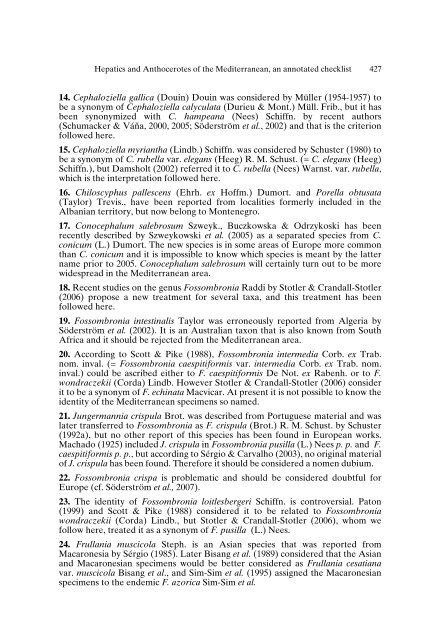Hepatics and Anthocerotes of the Mediterranean, an ... - NTNU
Hepatics and Anthocerotes of the Mediterranean, an ... - NTNU
Hepatics and Anthocerotes of the Mediterranean, an ... - NTNU
You also want an ePaper? Increase the reach of your titles
YUMPU automatically turns print PDFs into web optimized ePapers that Google loves.
<strong>Hepatics</strong> <strong><strong>an</strong>d</strong> <strong>Anthocerotes</strong> <strong>of</strong> <strong>the</strong> <strong>Mediterr<strong>an</strong>e<strong>an</strong></strong>, <strong>an</strong> <strong>an</strong>notated checklist 42714. Cephaloziella gallica (Douin) Douin was considered by Müller (1954-1957) tobe a synonym <strong>of</strong> Cephaloziella calyculata (Durieu & Mont.) Müll. Frib., but it hasbeen synonymized with C. hampe<strong>an</strong>a (Nees) Schiffn. by recent authors(Schumacker & Vá≈ a, 2000, 2005; Söderström et al., 2002) <strong><strong>an</strong>d</strong> that is <strong>the</strong> criterionfollowed here.15. Cephaloziella myri<strong>an</strong>tha (Lindb.) Schiffn. was considered by Schuster (1980) tobe a synonym <strong>of</strong> C. rubella var. eleg<strong>an</strong>s (Heeg) R. M. Schust. (= C. eleg<strong>an</strong>s (Heeg)Schiffn.), but Damsholt (2002) referred it to C. rubella (Nees) Warnst. var. rubella ,which is <strong>the</strong> interpretation followed here.16. Chiloscyphus pallescens (Ehrh. ex H<strong>of</strong>fm.) Dumort. <strong><strong>an</strong>d</strong> Porella obtusata(Taylor) Trevis., have been reported from localities formerly included in <strong>the</strong>Alb<strong>an</strong>i<strong>an</strong> territory, but now belong to Montenegro.17. Conocephalum salebrosum Szweyk., Buczkowska & Odrzykoski has beenrecently described by Szweykowski et al. (2005) as a separated species from C.conicum (L.) Dumort. The new species is in some areas <strong>of</strong> Europe more commonth<strong>an</strong> C. conicum <strong><strong>an</strong>d</strong> it is impossible to know which species is me<strong>an</strong>t by <strong>the</strong> lattername prior to 2005. Conocephalum salebrosum will certainly turn out to be morewidespread in <strong>the</strong> <strong>Mediterr<strong>an</strong>e<strong>an</strong></strong> area.18. Recent studies on <strong>the</strong> genus Fossombronia Raddi by Stotler & Cr<strong><strong>an</strong>d</strong>all-Stotler(2006) propose a new treatment for several taxa, <strong><strong>an</strong>d</strong> this treatment has beenfollowed here.19. Fossombronia intestinalis Taylor was erroneously reported from Algeria bySöderström et al. (2002). It is <strong>an</strong> Australi<strong>an</strong> taxon that is also known from SouthAfrica <strong><strong>an</strong>d</strong> it should be rejected from <strong>the</strong> <strong>Mediterr<strong>an</strong>e<strong>an</strong></strong> area.20. According to Scott & Pike (1988), Fossombronia intermedia Corb. ex Trab.nom. inval. (= Fossombronia caespitiformis var. intermedia Corb. ex Trab. nom.inval.) could be ascribed ei<strong>the</strong>r to F. caespitiformis De Not. ex Rabenh. or to F.wondraczekii (Corda) Lindb. However Stotler & Cr<strong><strong>an</strong>d</strong>all-Stotler (2006) considerit to be a synonym <strong>of</strong> F. echinata Macvicar. At present it is not possible to know <strong>the</strong>identity <strong>of</strong> <strong>the</strong> <strong>Mediterr<strong>an</strong>e<strong>an</strong></strong> specimens so named.21. Jungerm<strong>an</strong>nia crispula Brot. was described from Portuguese material <strong><strong>an</strong>d</strong> waslater tr<strong>an</strong>sferred to Fossombronia as F. crispula (Brot.) R. M. Schust. by Schuster(1992a), but no o<strong>the</strong>r report <strong>of</strong> this species has been found in Europe<strong>an</strong> works.Machado (1925) included J. crispula in Fossombronia pusilla (L.) Nees p. p. <strong><strong>an</strong>d</strong> F.caespitiformisp. p., but according to Sérgio & Carvalho (2003), no original material<strong>of</strong> J. crispula has been found. Therefore it should be considered a nomen dubium.22. Fossombronia crispa is problematic <strong><strong>an</strong>d</strong> should be considered doubtful forEurope (cf. Söderström et al., 2007).23. The identity <strong>of</strong> Fossombronia loitlesbergeri Schiffn. is controversial. Paton(1999) <strong><strong>an</strong>d</strong> Scott & Pike (1988) considered it to be related to Fossombroniawondraczekii (Corda) Lindb., but Stotler & Cr<strong><strong>an</strong>d</strong>all-Stotler (2006), whom wefollow here, treated it as a synonym <strong>of</strong> F. pusilla (L.) Nees.24. Frull<strong>an</strong>ia muscicola Steph. is <strong>an</strong> Asi<strong>an</strong> species that was reported fromMacaronesia by Sérgio (1985). Later Bis<strong>an</strong>g et al. (1989) considered that <strong>the</strong> Asi<strong>an</strong><strong><strong>an</strong>d</strong> Macaronesi<strong>an</strong> specimens would be better considered as Frull<strong>an</strong>ia cesati<strong>an</strong>avar. muscicola Bis<strong>an</strong>g et al ., <strong><strong>an</strong>d</strong> Sim-Sim et al. (1995) assigned <strong>the</strong> Macaronesi<strong>an</strong>specimens to <strong>the</strong> endemic F. azorica Sim-Sim et al.






